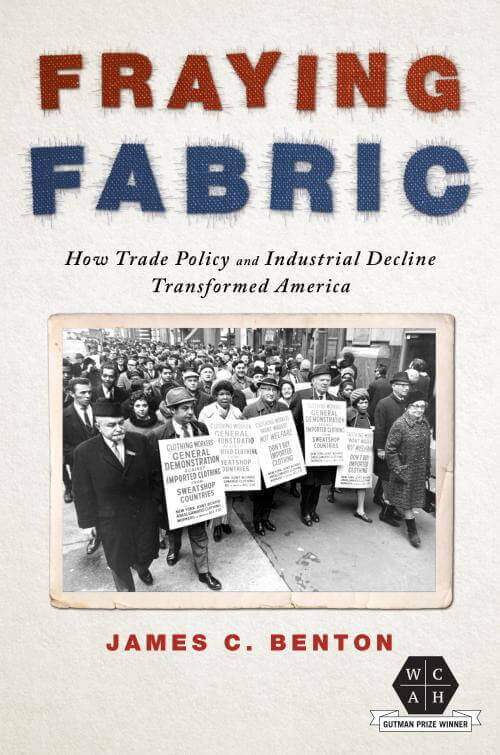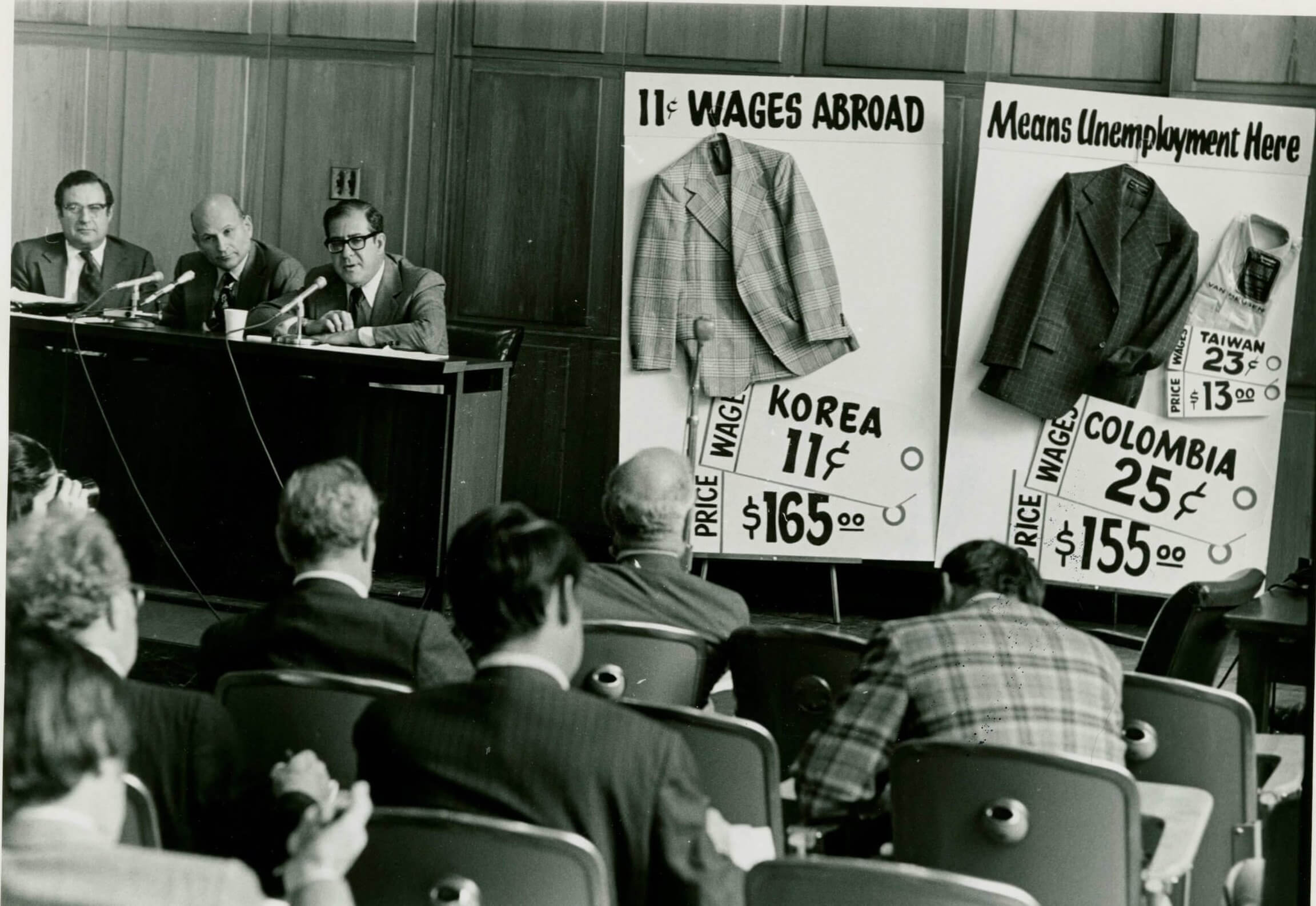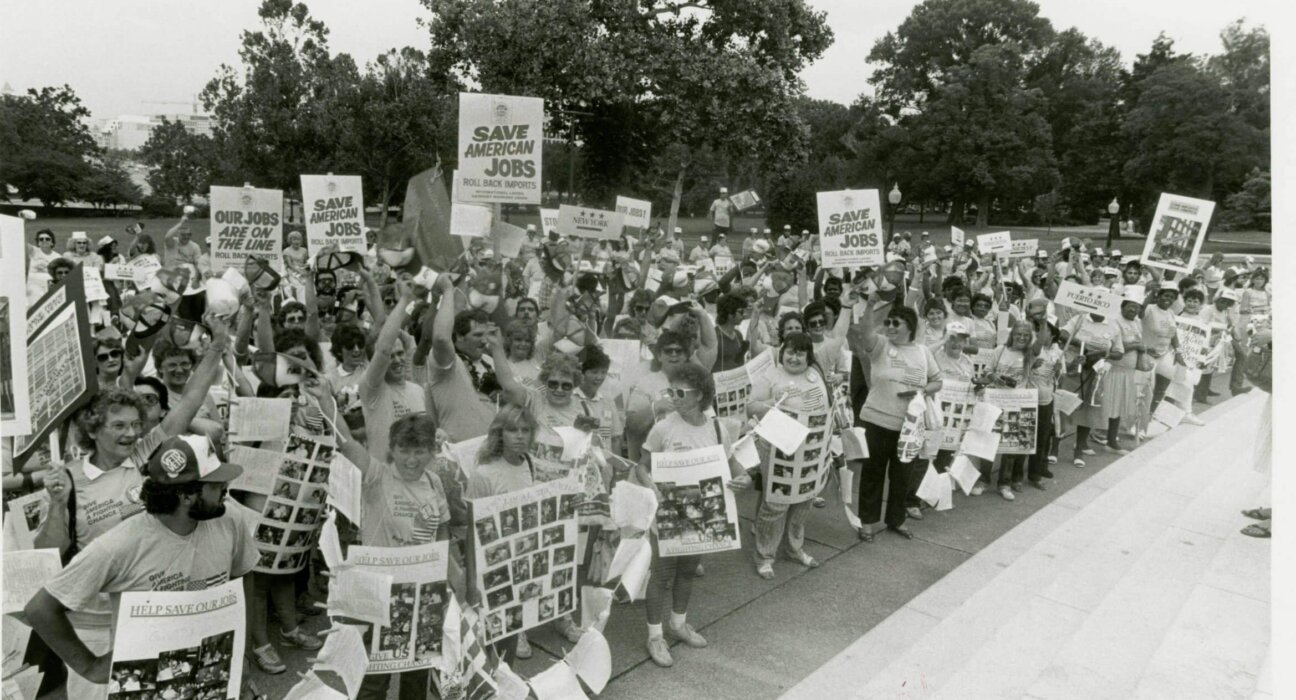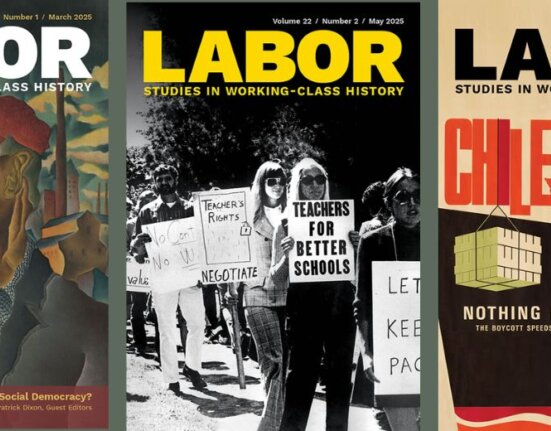James C Benton’s 2022 Fraying Fabric: How Trade Policy and Industrial Decline Transformed America (University of Illinois Press, 2022) asks important questions about the origins of trade and industrial policy, a topic that has driven anger among working-class, escalated anti-import sentiment, and driven U.S. politics. Benton covers the time before the North American Free Trade Agreement, which is more familiar to historians. His commentary in this interview offered some insights into the multi-faceted exploration of the way that workers in textile and apparel industries lives were transformed in the mid-twentieth century. His book reveals that trade policies that left workers voice out has a longer history than we usually imagine. But, he insists, workers have always wanted a seat at the table.
How did you come to be interested in trade and labor issues, and why do you think understanding this history contributes to the importance and understanding of labor history?

My interest in these issues came from my formative years. I grew up in a southern textile community that was also hostile to labor. The mills offered hard jobs that didn’t pay well, but they were nevertheless a vital part of the local economy. My hometown was deeply reshaped by the North American Free Trade Agreement. It was one of many communities that fell on hard times amid the post-NAFTA collapse of the U.S. textile industry. Those economic changes sparked bitter resentment among people who felt politicians had sold them out through trade agreements. I knew that NAFTA was part of the answer, but there was more to the picture. What had textile workers previously said about trade policy? And did textile workers try to stop these trade agreements? Those questions led me to find opinions of textile and apparel workers, elected officials, and industry executives on trade policy. Those opinions, and the actions of labor, business, and government on trade since the New Deal yielded Fraying Fabric.
Workers have always been keenly interested in a stable economy. Yet we too often limit workers’ interest in economic stability to gains sought through collective bargaining. In other cases, labor history explores economic gains through the lens of social movements. I think it’s also important to consider American workers’ interest in trade amid our current trade framework. And that means more than workers, or the labor movement, fighting trade agreements that benefited corporations and the rich. That means understanding workers’ and unions’ support of trade and economic policies to create a broad-based prosperity. In my research, I found American workers whose interest in trade was limited to arguing for protectionism of U.S.-based industries . But American workers also wanted to uphold the standard of living they had created. This was especially important after World War II, as the world economy was rebuilding. Workers’ view of a broad-based prosperity is an important part of labor history we must not forget. It shows workers wanted to use policy – not just collective bargaining – to reshape their world.
Your book deepens an understanding of the role of the Democratic Party, and the New Deal order in policy issues. While labor historians are familiar with Judith Stein’s book, Running Steel, Running America (1998) on the abandonment of the steelworkers, your book suggests that we need to start earlier than the 1970s, to go back to the New Deal itself to understand how industrial policy was shaped (or ignored) for the garment and textile industry. I would characterize your intervention as seeing textiles and garments as a kind of canary in the coal mine in regard to trade and labor issues. Can you tell us why it’s important to start with the New Deal instead of the 1970s?
Contemporary trade and labor policy are both connected to the New Deal. This includes the Wagner Act and the Reciprocal Trade Agreements Act of 1934 (a bedrock of American trade policy). Understand the history of the Wagner Act, and you know why labor’s current popularity hasn’t boosted U.S. labor density. Similarly, low-wage import competition, runaway factories, and capital mobility were longstanding economic challenges. In the domestic textile and garment industries, these challenges presented themselves repeatedly in the twentieth century. The textile industry in particular was limping along before wartime production gave it a midcentury lift. The presence of trade and labor challenges in the 1970s were a continuation of long-established trends, not a new phenomenon. Starting with the New Deal, not the 1970s, helps when investigating trade, labor, globalization, and deindustrialization and their effects. By doing so, we get a more comprehensive understanding of the impact of globalization on workers and domestic industry. In turn, we emerge better equipped to think about how these challenges unfolded and how to address them.
You clearly state that labor leaders like AFL-CIO President George Meany were willing to sacrifice garment and textile workers’ jobs for a Cold War agenda. Could you summarize some of that argument, and how the position changed?
In 1962, Meany and the AFL-CIO supported President Kennedy’s successful plan to revamp U.S. trade policy. At that time, the newly formed European Economic Community (the forerunner of the EU) was growing. The EEC was poised to become a prized trading partner with the Soviet Union or the United States. Meany argued that increasing international trade would help the U.S. fight communism, even if American workers were harmed. The federation supported Kennedy’s trade policy, but it was not unanimous. Union officials in import sensitive industries, like textiles and apparel, were concerned their workers would face greater import competition. But they did not have enough power within the federation to shift its position. By 1967, worries about import competition had moved into other manufacturing sectors, such as electronics, chemicals and steel. That year, American unions mounted an unsuccessful effort to block tariff reductions reached in the Kennedy Round of GATT. As concerns about imports spread to unions outside textiles and apparel, the AFL-CIO questioned its longstanding support of free trade. Between 1967 and 1969, the federation increasingly called for “fair trade” to benefit all nations. As economic challenges grew through the early 1970s, the federation moved away from free trade. By 1974, it opposed what became the Trade Act of 1974, a major revision of U.S. trade policy.

There are so many images of a diverse working class advocating for tariffs and trade policy in your book. Could you tell us a little about those photos and what they tell us. I’m reminded of the famous ditty, “Look for the Union Label” by the ILGWU in the 1970s, which also carried that theme of a diverse working class arguing for protection against imports. Is there a way to imagine an empowered working class saving that industry? If so, how might it have mattered?
To me, the photos illustrate the range of workers who were advocating on behalf of their jobs, communities, and industries. It’s possible to view those photos and see workers spanning class, gender, race, immigrant status, and (most) regions. And they’re conveying a variety of messages. They urge consumers to use their dollars to support domestic industry. They advocate saving industries as a means of providing advancement for women and a variety of racial and ethnic groups. They voice frustration at the effects on the working classes of postwar reconstruction and trade policy. Sometimes the message isn’t as positive. Some of the photos (I omitted most from the book) reflect resentment against workers abroad, either through slogans or stereotypes. Nevertheless, these photos shatter any assumptions of a quiescent working class, especially on trade issues.

Employment levels in the U.S. textile and apparel industry have plummeted 90 percent in the past half century. I believe the elements existed to create an empowered working class that could have saved the industry. Textile and apparel workers were employed in every state of the union. Their factories were in large cities, suburban enclaves, and small rural towns. That broad base had significant support in Congress and state legislatures through much of the twentieth century. And until the early 1980s, labor, business, and government had a shared interest in saving this industry.
So why didn’t it happen? A significant barrier prevented the rise of an empowered working class in this industry. That was the lack of unionization among southern textile workers, whether by company opposition or failed organizing efforts. If southern textile workers had organized, the results for the industry might have been different. Workers and industry could have united well before the 1980s in efforts to protect the industry. Politicians, especially the southern Democrats within the New Deal coalition, would likely have been more amenable to a worker-industry alliance. Stronger, larger textile and apparel unions may have forced the AFL-CIO to address trade policy before the late 1960s.
Of the missteps on trade by labor, capital, and the state, the silencing of labor was extremely critical. Broader organizing of the southern textile workforce could have yielded a formidable force capable of saving the industry. It could have also affected regional development, and possibly altered the arc of national politics through the late twentieth century. Viewed in that light, the historic failure to organize the South’s largest industrial force continues to reverberate. Our nation’s contemporary and future social, economic and political makeup will be shaped by that failure. One can only imagine the different places the nation might be today if that trajectory was different.
For decades, mainstream economists argued that expanded “free trade” and reduction of barriers would lift all boats and that the US working class would benefit by economic growth through free trade. Now some have acknowledged the need for industrial policy. What would you tell those economists about what your book shows from the experience of textile and garment workers?
Economists can learn the need for industrial policy from the example of textile and garment workers. Elected officials, technocrats, and capitalists all thought they knew better as they embraced free trade in the postwar era. Instead, we got a race to the bottom. Capital floods into low-wage areas, leaving developed areas hollowed out. The lack of an industrial policy in the United States ushered in tax incentives and a beggar-thy-neighbor politics of scarcity. Now we have cities, regions, and states competing to give companies large incentives with no guarantee those companies will stay.
An industrial policy would help avoid this chaos. If labor, capital, and the state cooperate, they can create policies that produce good jobs, thriving businesses, and stable communities. I wrote about labor’s efforts to design policies to help workers and communities affected by trade. But those policies were piecemeal, underfunded, and eventually overtaken by promises of free trade benefits that never came. In recent years, we’ve seen a turn toward industrial policy. In a recent review of my book, Justin Vassallo (Vassallo-Review) indicates that supply chain shortages prompted by the Covid-19 pandemic and the developing energy transition have, together, given the Biden administration an opening to implement an industrial policy in the United States as a means to build the domestic economy. In addition, the increase in U.S. worker activism over the past few years shows workers’ interest in reaping the benefits of the prosperity they produce is as strong as ever – even if it has yet to boost the long-term outlook for the American labor movement. Billionaires aren’t the only ones with dreams out here! Workers have a vision of the kind of world they want to see, and they’re working to manifest that vision.

We need more effort to build a domestic industrial policy that serves as an investment in workers, families, businesses, and communities. We also need that industrial policy as a tool of social insurance in the United States. Around the world, we see numerous examples of radicalization among people who are excluded from economic and social opportunities. The contemporary rise of fascism in this country is due in part to economic and social exclusion. An industrial policy would help reduce that pressure among Americans at risk of economic exclusion and radicalization. It would encourage responsibility over pathology; offer stability for workers, families, and communities; and promote steady balanced economies. If we embrace industrial policy that benefits workers and communities, not just businesses, we may be pleasantly surprised beyond our wildest dreams.

James C. Benton is director of the Race and Economic Empowerment Project at the Kalmanovitz Initiative for Labor and the Working Poor at Georgetown University. Dr. Benton’s historical and research interests include labor and social movements, public policy, and United States history from the New Deal to the present. He is a co-designer of Creating an Equitable City, a project starting in the spring of 2024 with Georgetown’s Capitol Applied Learning Lab. This three-year project is designed to help students understand the existence of inequality in Washington, D.C. in areas such as housing, healthcare, and criminal justice, and develop policy and community approaches to reduce or eliminate those inequalities.
Before entering academia, Dr. Benton was a journalist and nonprofit researcher. His journalism career began as a wire service reporter with the Associated Press, moved to newspapers in North Carolina and Ohio, and ended with a newsmagazine covering Congress. His nonprofit work included investigations on money in politics, whistleblower protections, and congressional ethics, as well as lobbying for the 2006 reauthorization of the Voting Rights Act.






